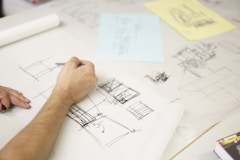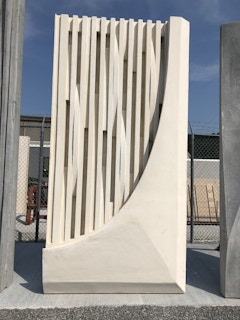
165 results
-

-

Environmentally Responsible Wood Cladding
- Paper by Pratibha Chauhan, Workplace Strategist Doug Bergert, AIA, LEED AP, Senior Project Designer, Associate
This case study focuses on the solutions provided for the Bell Museum at the University of Minnesota. Our design team worked with the client to… -

Architectural Ceramic Assemblies
- Paper by Omar Khan, Bill Pottle, Mitchell Bring,
This paper documents a six year academia/industry collaboration between researchers at the Department of Architecture, University at Buffalo (SUNY)… -

Printed Facades? Cases of Additive Manufacturing in the Building Envelope
- Article by Philipp L. Rosendahl · Chris Borg Costanzi · Philipp A. Chhadeh · Robert Akerboom · Benedikt Waldschmitt · Alexander Wolf · Marvin Kehl · Ulrich Knaack
This paper, written by a team at the Technical University at Darmstadt, uses examples of 3D printed structural glass, reinforced thin-sheet façade panels, and nesting bricks that can be integrated directly into facades to support work successful industrial applications.
-

building HEALTHY building(s): PhilaU Places 5 in the top 10 Finalists in International Student Competition
Architecture students from Philadelphia University took five of the top ten spots in the building Healthy building(s) competition. The student competition was conducted as a precursor to an upcoming conference...
-

Form Follows Well-Being: An Approach to Human Centric Facade Design
- Article by Timo Schmidt, Prof. Dr. · David Bjelland, M.Sc.
Professor Timo Schmidt and Research Assistant David Bjelland of the University of Applied Sciences, Augsburg, propose a human centric planning guide for façade design that provides a tool to optimize façade components to match enhanced occupant well-being and health.
-

Research Collaboration between Industry and Academia as a Driver for Facades Innovation
- Article by Alexandra Blakeslee · Helen Sanders, PhD
Technoform recently embarked on a research project with the University of Massachusetts Amherst and are excited about the opportunity to collaborate with academia. We believe that building strong partnerships and networks that lead to shared results progresses the industry.
-

Resilient SKINS: Bending with the Wind
- Article by Mic Patterson, PhD LEED AP+
Are you resilient? Do you bend to the winds of change or do you resist? Do you bounce back from adversity or is your recovery long, slow, and incomplete? Do you readily adopt lifestyle changes in response to personal health, economic, or environmental challenges, or is your response one of denial?
-

Highly Efficient Façades with Innovative Shading and Light Control
- Paper by Klaus Reuschle, Project Director Robert Matthew Noblett, Partner Michelle Siu-Ching Lee, Roman Schieber, Associate Director ppa.
The Science and Engineering Complex (SEC) on the Allston Campus is the largest new building at Harvard University in recent decades with a footprint… -
Face Time: Introducing the Facade Tectonics Institute
- Press Release
There is history to this new enterprise. Facade Tectonics started as a series of invited roundtable discussions at the University of Southern California School of Architecture in 2007 as a strategic response to the escalating importance and complexity of building facade technology. These roundtable
-
Cool precast concrete enclosure studies from Washington U. in St. Louis
- Article by Pablo Moyano Fernandez, Assistant Professor
Precast Concrete Enclosures is an elective course taught by Assistant Professor Pablo Moyano Fernandez at Washington University in St. Louis. The primary goal of the course is to enable students to envision and materialize full-scale building envelopes using precast concrete.
-

Sustainababble: Moving beyond talk and taking action!
- Article by Mic Patterson, PhD, LEED AP+
Well, here we are well into the new year, for better or worse only time will tell. It seems that adversity fails to slow the clock; I don’t know about all of you, but certainly for me and others I’ve talked with time continues to flow at speed, perhaps even accelerating.
-
Facade Tectonics Institute Announces Second World Congress
- Press Release
The Facade Tectonics Institute will convene its second World Congress on March 12-13, 2018, in Los Angeles at the University of Southern California. The theme of this year’s conference, “Skins on Campus: Bridging Industry and Academia in Pursuit of Better Buildings and Urban Habitat,” focuses on the
-

Architectural Glass Institute Sponsors Second Annual Architectural Glass Student Design Competition
- Article by Stephanie Staub, CSI, CDT, LEED Green Associate, Marketing Director
The Architectural Glass Institute (AGI) of Philadelphia, Pa., sponsored its second annual Architectural Glass Student Design Competition in January, where third-year Jefferson University architecture students competed to design glass learning pods.
-

Academic Wood Tower Choreography
- Paper by John Peterson OAA FRAIC LEED AP BD+C · Leland Dadson OAA CPHD
With an ever-growing interest in mid- and high-rise mass timber construction, this paper highlights the insights and lessons learned across global
-
Recent Adaptive Textile Façade Systems
- Paper by Lucio Blandini · Moon-Young Jeong · Michael Voigt · Jonathan Lopez · Hannah Schürmann · Arina Cazan · Hannah Raisch · Daniel Roth · Maria Matheou
Adaptive facade systems are a promising approach to achieve a dynamic response to varying weather conditions and user demands. The interdisciplinary
-

Episode 06: 2020 World Congress Series | End-of-Life Challenges in Facade Design
- Podcast by Rebecca Hartwell
Dive deeper into the top papers from the 2020 World Congress! We invite you to tune in to the third episode of the series with Rebecca Hartwell, PhD Candidate at the University of Cambridge, who will be speaking about her winning paper, "End-of-Life Challenges in Facade Design."
